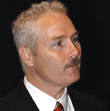People to watch in 2004

Everyone's new year starts with a long list of resolutions and goals. For these government and industry executives, that list also includes challenges and problems that will have repercussions beyond their own companies or organizations. The government IT community will be marking closely their successes and failures.
Everyone's new year starts with a long list of resolutions and goals. For these government and industry executives, that list also includes challenges and problems that will have repercussions beyond their own companies or organizations. The government IT community will be marking closely their successes and failures. chief executive officer of DigitalNet Inc. Bajaj is looking for lightning to strike a third time. He has built and sold two successful companies: I-Net, which he sold to Wang Laboratories in 1996, and AppNet, which he sold to Commerce One in 2000. Now, it is DigitalNet's turn. He formed the company in 2002 and acquired the federal government business of Getronics, which, by coincidence, had acquired Wang. In October, he took DigitalNet public and said he is ready to make acquisitions and grow the company at 22 percent to 25 percent annually. Another sign of Bajaj's seriousness are some of his hires. He has been able to snag Norm Lorentz, chief technology officer at OMB and Debra Stouffer, former CTO at the Environmental Protection Agency. program manager of Project SafeCom. Boyd took over the troubled wireless communications initiative when it failed to meet its goals last spring and was transferred from Agriculture to the Homeland Security Department. Since then, Boyd has sought to galvanize federal, state and local officials to build interoperable communications systems that will improve the nation's ability to respond to emergencies and disasters. But he is still working on a shoestring budget and faces the challenge of getting agencies to stop squabbling and work together.[IMGCAP(2)] corporate vice president and president for federal sector at Computer Sciences Corp. CSC has suffered blows to its image in recent months. The government announced the company would miss an important deadline on Trilogy, the FBI's IT modernization project, and the IRS Oversight Board threatened to remove CSC as the prime contractor on the IRS modernization contract. Cofoni must move quickly to make necessary fixes on these projects, while persuading other would-be government customers that CSC has not lost the edge that has made it one of the premier IT contractors.CEO of Science Applications International Corp. Dahlberg is replacing a legend: Founder Robert Beyster, who turned SAIC into the largest employee-owned research and engineering company. Rather than promoting from within, an SAIC search committee tapped Dahlberg from [IMGCAP(3)]General Dynamics Corp., where he headed the company's information systems and technology group. Dahlberg takes the reins with Beyster looking over his shoulder as chairman of the board.head of state and local government for EDS Corp. After 10 months on the job, the former Michigan governor is under the gun to start producing for EDS' state and local practice, which has lost competitions for key Medicaid outsourcing deals in Texas and Georgia. He will need to tap his political skills to overcome a lackluster market and rejuvenate the company's flagging state and local business. administrator for e-government and information technology at the Office of Management and Budget. Industry executives are waiting to see if Evans takes the work of her visionary predecessor, Mark Forman, to new heights or if she leads federal IT in a new direction. Forman launched 24 cross-agency e-government projects that forced agencies to pool their resources. Evans is expected to focus on completing the 24 initiatives and on more complex projects in public-health monitoring, criminal investigation, human resources administration and financial management. president of the American Federation of Government Employees. As the new union president, Gage will lead the fight against the Bush administration's effort to compete thousands of federal jobs with the private sector. Gage will continue AFGE's lobbying for anti-outsourcing provisions on spending bills. He has come out swinging with two television advertisements running in Iowa and New Hampshire, both early presidential primary states. One criticizes no-bid contracts for rebuilding Iraq, and says: "When contractors go over budget or commit fraud, it seems as long as they keep writing big contribution checks to the Bush campaign, they just keep getting more government contracts paid for by you and me." executive commissioner of the Texas Health and Human Services Commission. Hawkins' challenge is consolidating 12 health and human services agencies into four streamlined departments for the Lone Star State. If this groundbreaking approach, which might include privatizing certain functions, works, it may spark similar efforts in other states. chief architect at the Office of Management and Budget. Although he officially assumed the job last November, Haycock has been working on the federal enterprise architecture program for more than a year and a half. Now he has to sell government agencies on a series of reference models that will allow their systems to share information more efficiently, and allow chief information officers to better manage IT. As OMB compares agency architectures to the federal framework, Haycock and company may have a significant impact on the way agencies buy and implement technology. managing partner of Government East Client Group with Accenture Ltd. After 21 years at the company, Mitchell was promoted to oversee state and local operations in the eastern half of the country at the end of 2003. His marching orders are to continue expanding the company's footprint in customer relationship management, enterprise resource planning and IT outsourcing.[IMGCAP(4)] R-Fla., chairman of the House Government Reform subcommittee on technology, information policy, intergovernmental relations and the Census. As Congress' leader on cybersecurity, Putnam will push agencies to improve their dismal track re-cords. He will also prod industry, through voluntary agreements or legislation, to tighten their own controls. Putnam plans strong oversight of e-government as the 24 cross-agency initiatives grow into standalone systems used governmentwide, and the Office of Management and Budget plans new initiatives. Putnam will push for governmentwide coordination of IT research and development, and archiving that adheres to established standards. president and chief executive officer of the Boeing Co. Stonecipher was called out of retirement to take the helm at the troubled aerospace company after a series of ethics scandals led to the resignation of Phil Condit. Stonecipher was president and CEO of McDonnell Douglas Corp. in 1997 when it merged with Boeing; he became president and COO of the company until he retired in 2001. His reputation as a hard-nosed businessman with in-depth knowledge of government markets may stand him in good stead as he tries to rebuild confidence in the company.[IMGCAP(5)] director of the U.S. Visit program at the Homeland Security Department. The U.S. Visitor and Immigration Status Indication Technology system, or U.S. Visit, is one of the biggest challenges the federal government has ever faced, and it's Williams' baby. The $7 billion ? or much more ? project will overhaul completely the nation's border entry points for foreign visitors and immigrants, and track their visa status during their stays. Congress will be watching closely and releasing funds in dribs and drabs as the program progresses. The contractor community sees Williams, who came to the position from a similar role at the IRS, as one of the most able project managers working in government today. director of the National Cyber Security Division at the Department of Homeland Security. Before selling his security firm to Symantec Corp., Yoran was assessing network vulnerabilities for the Computer Emergency Response Team at the Defense Department. Now he is tasked with implementing the National Strategy to Secure Cyberspace, which is to say keeping worms such as Blaster from bringing government networks to their knees. Yoran plans to tap the private sector for cooperation and expertise, and he will need all the help he can get: The federal government got an overall grade of D on its 2003 security report card.





Ken Bajaj,
David Boyd,
Paul Cofoni,
Ken Dahlberg,
John Engler,
Karen Evans,
John Gage,
Albert Hawkins,
Robert Haycock,
Kenny Mitchell,
Rep. Adam Putnam,
Harry Stonecipher,
Jim Williams,
Amit Yoran,

Karen Evans, administrator for e-government and information technology at the Office of Management and Budget, leads the list of feds to watch.

Paul Cofoni

Ken Dahlberg

Rep. Adam Putnam

Jim Williams
Ken Bajaj,
David Boyd,
Paul Cofoni,
Ken Dahlberg,
John Engler,
Karen Evans,
John Gage,
Albert Hawkins,
Robert Haycock,
Kenny Mitchell,
Rep. Adam Putnam,
Harry Stonecipher,
Jim Williams,
Amit Yoran,


